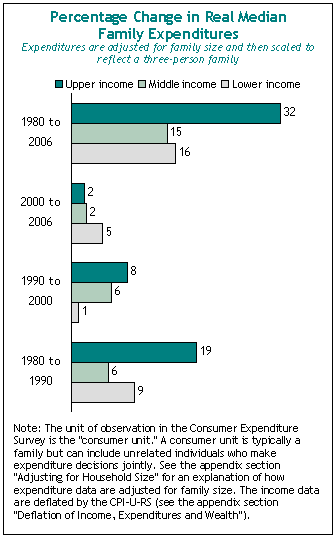One of the important changes in the economic life of the middle class over the past quarter century has been the extent to which it has engaged in higher levels of consumption and taken on a higher burden of debt. At least until the current recession, housing was the key driver of both trends.
From 1980 through 2006, middle income families increased their inflation-adjusted expenditures by 15%. In part, that’s because the  cost of many of the anchors of a middle class lifestyle — housing, health care, education — rose more sharply than inflation. It’s also because many new goods and services that didn’t exist a few decades ago — high speed internet, cable and satellite subscriptions, high definition television, among others — have become commonplace consumer items. (As the chart to the right illustrates, many in the middle class tend to overestimate just how commonplace these items are — creating a “possessions perception gap” that may have fueled some of this consumption).
cost of many of the anchors of a middle class lifestyle — housing, health care, education — rose more sharply than inflation. It’s also because many new goods and services that didn’t exist a few decades ago — high speed internet, cable and satellite subscriptions, high definition television, among others — have become commonplace consumer items. (As the chart to the right illustrates, many in the middle class tend to overestimate just how commonplace these items are — creating a “possessions perception gap” that may have fueled some of this consumption).
The 15% growth in real consumption by the middle income over this time period is about the same at the change experienced by lower income families (16%) but only about half the rate of growth experienced by upper income families (32%).
Somewhat more so than for the income groups above and below them, the middle tier paid for its increased consumption by taking on more debt, most typically in  the form of bigger mortgages and second mortgages. Thus, the median debt-to-income ratio of middle income households more than doubled from 1983 to 2004; these rates also rose for the other lower and upper income groups, but not quite at the accelerated pace of the middle group.
the form of bigger mortgages and second mortgages. Thus, the median debt-to-income ratio of middle income households more than doubled from 1983 to 2004; these rates also rose for the other lower and upper income groups, but not quite at the accelerated pace of the middle group.
Obviously, housing values, expenditure patterns and debt habits are much different today than they had been just a few years ago. It’s beyond the scope of this report to analyze these more recent developments, in part because of the lag time in the availability of some of the key data. The story told by the numbers presented here essentially ends before the start of the current recession. But it helps to provide a context for — and perhaps to foreshadow — current developments.




